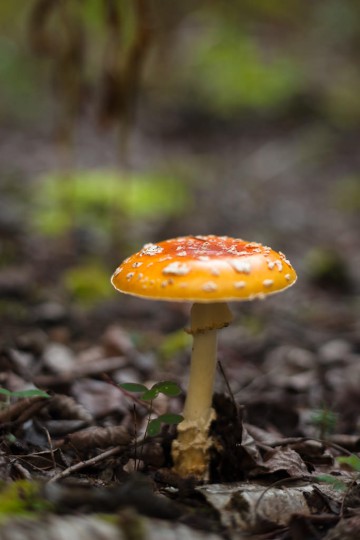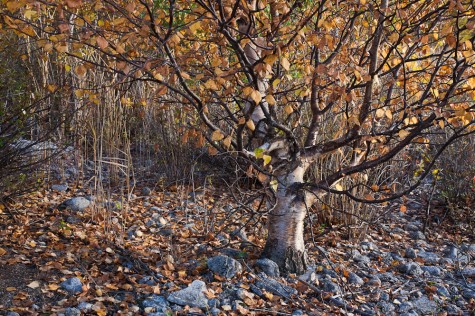 Warm sunlight on morning mist This is another photo from my latest trip out to Ministik. It was a gorgeous, calm morning: warm enough to be comfortable, but cool enough to keep the mosquitoes down and the mist rising from the lakes.
A few of my prints have come out with slight colour casts, usually a (very little) bit greenish, so I tried this one tonight as the colour of the rising mist is very important to the feel of the photograph. We’ll see how it turns out…
 Fresh amanita mushroom Almost exactly two years ago (less one day), I had the opportunity to photograph a tremendous diversity of mushrooms at Ministik (click here to view a gallery of images). Today, I went back to the same spot and, while the diversity was much lower than the previous year, there were some great mushrooms out—and I had a great time photographing a few of them. This is a very fresh, still growing “Fly Agaric” or “Fly Amanita” mushroom (Amanita muscaria). Beautiful to look at—and photograph—but don’t eat it!
 me photographing mushroom For most of the morning, I used my 50mm f/1.4 and flipped the centre column of my tripod upside down to make low-angled, shallow depth-of-field photographs of these mushrooms. I see mushrooms like this often while doing field work, but rarely have the time to take deliberate, careful photos of them. I’ll share a couple more from this morning in the next little while, so please come back again soon. (Here’s a quick photo of my hard at “work” this morning…)
 First fall colour So, I’m back from my work in Fort McMurray, I’ve had a chance to rest up a bit, and I’m looking forward to resuming my project of making a new print every day. Just a simple print today from a photograph that I took early last September at the Ministik Game Bird Sanctuary. I’m headed out to Ministik tomorrow morning for the first time in a long while, and hope to come back with some new photographs that I can share here.
 Three autumn birch It’s been a long time since I’ve posted a new photo, and to be honest, it’s been a while since I’ve made any new images. I have been working on re-processing some images into black and white, including this one here.
I love a great B&W photograph, and after listening to this podcast by LensWork editor, Brooks Jensen, I’ve been inspired to figure out for myself what it takes to make a great B&W image, rather than a pretty-good image. And, thanks to the flexibility afforded by capturing and processing digitally, I’ve been going through my image catalogue and giving it a try.
 Dried Goldenrod leaves with hoar frost Although this photograph was from a little earlier in the season than my last post, it was a similarly frosty, beautiful day. It’s amazing how a lining of frost can add definition and visual interest to an otherwise subdued scene. This is especially true when photographing with the sun behind your subject, the backlighting making the frost shine while the rest of the subject remains shadowed. I also added a fairly heavy vignetting effect while processing this image, to further draw attention to the lines created by the curled, dried goldenrod leaves.
 Frost covered trees on bright winter day It’s been too long since I last posted a new photograph—my apologies. Here is an image I made recently, on a particularly gorgeous afternoon at the Ministik Lake Game Bird Sanctuary just east of Edmonton. All of the trees, shrubs, and even each blade of grass was bearing a thick covering of frost. The sky was perfectly clear and everything was sparkling—it was beautiful (and cold).
When I was processing this photograph, I used the digital equivalent of the technique of placing a red filter in front of the lens to darken the blue sky. This technique (a favourite of Ansel Adams) adds a dramatic look to the sky and making the brightness of the foreground trees stand out even more.
 Paper Birch along rocky Ministik shoreline It is unusual to find exposed rock along the shores of the lakes in this part of Alberta, but this beautiful shoreline along Oliver Lake in the Ministik Game Bird Sanctuary just east of Edmonton had several hundred meters of this gorgeous blue-grey stone typical of the Beaver Hills/Cooking Lake moraine landform. Tall reeds and grasses, all dried up by this time, grew from between the stones and above the high water mark there were aspen, birch, and spruce. And then there was this tree—growing near the water in a little clearing.
My timing was just right—all the tree’s leaves had turned to this reddish yellow, with a few fallen to the ground to contrast the colour of the rocks (the next few days were quite windy, stripping most of these leaves for the season). When I first arrived at this spot, the sun was reasonably low in the sky, but the white bark of the birch tree was still reflecting too much light and the contrast was more than my camera could capture. Sometimes, bracketing exposures and combining them to an HDR image for processing can reign in such high-contrast scenes, but in this case a slight breeze was rustling the leaves and grass stems, which makes it very difficult to blend multiple exposures successfully.
Looking to the west however, I noticed that a bank of high stratus clouds rose a few degrees above the horizon in the otherwise perfectly clear sky. Normally, this is bad news if you’re trying to photograph dramatic late-day sidelighting and sunset colours (which I was trying to do). In this case though, I waited until the sun had just dipped behind the thin leading edge of the clouds, causing the light to dim a little and to diffuse ever so slightly—reducing the contrast in the scene, but still lighting the brilliant fall colours. I hurried to capture a few compositions that I’d determined while waiting for the light, and far too quickly—the light was gone. I walked back to the truck as the lacklustre sky simply grew darker with the sun hidden behind the advancing clouds—but I couldn’t possibly have been any happier.
|
(Click photos to enlarge)
|









